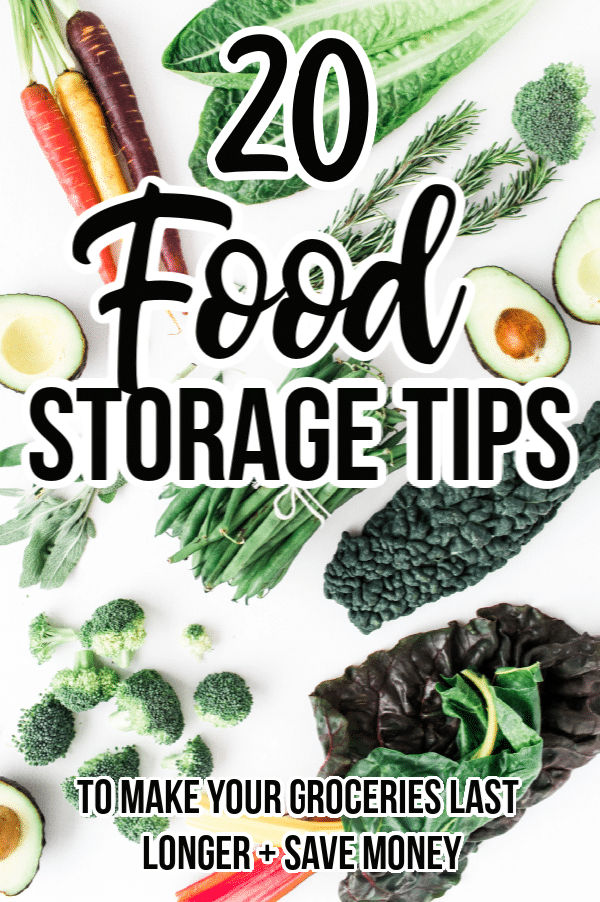The Best Way to Store Food! Follow these 20 Food Storage Tips and you’ll be on your way to optimal food flavor and saving money by having little waste!
Have you ever wondered where the best place is to store food items in your kitchen? When you come home from the grocery store or finish up a meal and have leftovers, you may not be sure whether to leave your food on the counter, refrigerate or freeze it.
Well, today you’re going to learn the best places to store your food items to limit your food waste and extend the life of your food!
Make certain to check out my 4 Money Saving Tips for Grocery Shopping so you can find out how to make your groceries work best for you. These Easy Meal Solutions for Busy Families are a must as well.

Food Storage Tips for Your Groceries and Leftovers
Follow these 20 Food Storage Tips for your refrigerator, freezer, and pantry and you’ll be on your way to optimal food flavor and saving money by having little waste!
BEST TIPS FOR STORING FRESH FOOD IN THE FRIDGE
You have more room in your fridge than you think! These tips can help you store produce so that it’s fresh and ready to enjoy.
Meat/Poultry: Keep meat and poultry in their original packaging in the refrigerator. To freeze, slip the packaging into a resealable freezer bag.
Seafood: Leave seafood in its original packaging and, if possible, place it on a bowl of ice in the refrigerator. If not eating right away, freeze seafood by slipping the original packaging into a resealable freezer bag.
Dairy: Should be kept in the refrigerator. Soft cheeses, like Brie and mozzarella, can be kept in an airtight container once open. Wrap semihard and hard cheeses, once open, in wax or parchment paper, then stow in a resealable plastic bag. Milk and Yogurt can be frozen by placing into freezer containers or freezer-proof glass jars, leaving 1 inch of space at the top to allow for expansion; once thawed, mix to redistribute the solids.
Ketchup/mustard/Condiments: Can be stored safely at room temperature for a few weeks. To extend the shelf life and flavor of these condiments, put them in the fridge, where they’ll be good for several months.
Fresh Pasta: Store in the fridge and buy what you’ll use in a few days so that it doesn’t become chewy or hard.
Vacuum-Sealed Smoked Fish/Deli Meats: Can be stored in the fridge unopened for extended periods — with a suggested “use by” date of several months. Once the package is opened, it’s good for up to five days in the fridge.
Refrigerated Fruits/Vegetables: Store like with like – apples with apples – carrots with carrots. Leave refrigerated produce unwashed in its original packaging or wrapped loosely in a plastic bag. Fruits and vegetables stored at room temperature should be removed from any packaging and left loose. If you can place them in a crisper drawer, that might help keep the leafy greens or other fruits and veggies fresh longer.
Whole Wheat Flour: Does need to be refrigerated. The whole grain parts can easily become spoiled at room temperature.
Leftovers: Store leftovers in airtight, leak-proof clear containers or wraps, refrigerating within two hours of cooking. Don’t refrigerate leftover canned food in cans – place in an airtight container. Once a can is opened, residual metal on the rim can leach into food and leave a metallic taste. Food storage containers are easy to buy and have on hand for leftovers.
EASY IDEAS TO STORE FOOD IN THE FREEZER
Have food that you want to keep fresh? Find out the best tips for storing excess in the freezer. This is a great way to keep it out of the elements and to keep it good until you’re ready to use it.
Coffee: While freshness is maintained with a small amount kept at room temperature and used quickly, it’s best to freeze larger amounts of ground coffee. It’s good for months with optimal flavor. You can store coffee in mason jars as well for quick use as long as the mason jars are freezer safe.
Nuts: With such a high-fat content, nuts can lose flavor and freshness, and even become rancid if kept at room temperature for too long. Keep your nuts in an airtight container or recloseable bag before freezing. If you allow in excess moisture, the nuts will love their crunch.
Bacon: While the suggested “use by” date for bacon can be several months, once the package is opened, it should be consumed within the next seven days for food safety. Try dividing into single serving sizes for convenience, and then thaw as needed in the fridge or microwave prior to cooking.
These 21 Simple Freezer Meals to Help You Easily Stock Up are a great resource to have!
HOW TO STORE SHELF-STABLE FOODS IN THE PANTRY (room temperature):
These tips are great for keeping food as fresh as possible for as long as possible.
Baked Goods/Bread/Snacks: Make sure baked goods are tightly wrapped or in an airtight container and stored in the pantry. (Dairy-based cakes and pies should go into the refrigerator) Bakery-style breads and baguettes should be kept in their original packaging at room temperature; Any crackers or snack foods will stay fresh longer in an airtight container or bag.
Tomatoes: Should not be refrigerated because they’ll lose flavor rapidly. They will continue to ripen at room temperature.
Oils/Vinegar: Can be stored in the pantry safely
White Flour: While white flour is stable in your pantry (keep the opened bag in a recloseable bag or separate container)
Whole Fruit: Fresh fruit will continue to ripen at room temperature, so leave it out for no more than about five days. To avoid spoilage, keep extra fruit in the fridge where it will not ripen at cooler temperatures. Fresh fruits need to stay in a cool place for best results.
Make certain to check out my 7 Easy Tips to Create A Meal Plan each week! PLUS a FREE Meal Plan Printable!
OTHER FOOD STORAGE TIPS:
– Make sure to use fresh, perishable foods soon after you purchase them. Make sure to maintain the proper temperature and humidity in your refrigerator and freezer. Check temperature every so often with a thermometer to check that the refrigerator is at 35 to 40 degrees F and the freezer at 0 F degrees or below. Even under proper storage conditions, foods lose freshness and nutritive value if they are stored too long.
– Signs of spoilage are a rancid odor, slime on the surface of meat. Off-odors in foods and a sour taste in bland foods can indicate dangerous bacterial spoilage. However, food can be high in bacteria count even without these signs. Make sure to check guidelines on how long to keep food.
– To retain quality and reduce waste, only buy the amount of food you can store properly. Make sure to maintain a clean refrigerator and freezer and avoid overcrowding the refrigerator so cold air can circulate freely.
-Once I open food, I keep it in plain sight in the fridge so that I remember it easily and understand that I need to cook it quickly so it doesn’t spoil or go bad.
-It’s a good idea to keep a small container and other reusable containers in your cabinets at all times. This will help your food supply stretch for leftovers and cut down on waste. I like to store leftovers in small quantities so that everyone can try different things for reheating.
-At the end of the week, go through the fridge and see what you have left. This is an easy way to see how much food you have and how much you need to store.
Even if you feel as though you’re storing food properly for later use, there is always a risk of food poisoning if you cut corners. Correctly stored food in ideal conditions is a great way to have long term storage. Make certain that you’re always aware of expiration dates on items as well so that you have a good rule of thumb of when food is no longer good to keep.
By following these 20 Food Storage Tips, you’ll be on your way to the freshest food with little waste in no time! Do you have food storage tips? Share them in the comments below! I’d love to hear! These are some of the best food storage tips that everyone can use!
Looking for even more kitchen and cooking tips? Try these posts next!









I found it helpful when you said that you could consider dividing bacon into single serving sizes so you could just thaw them as needed. This reminded me of my mother who wants to shop for a bulk of pork chorizo. She mentioned that she wants to be able to keep them fresh for a long time, so I will ask her to consider your tips. https://sabrosurafoods.com/our-products/